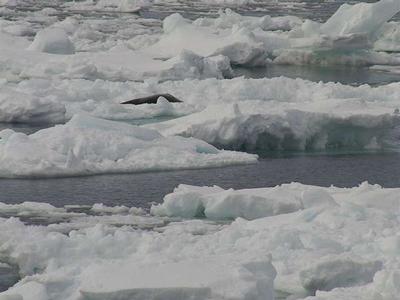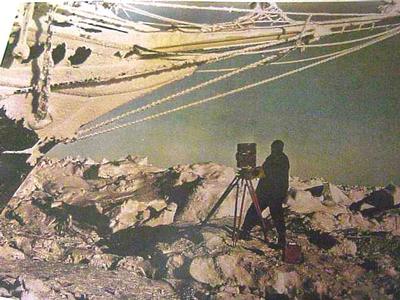22 February, 2001
-063 52 lat/ 101 25 long
Sea Ice averages about a meter thick but can vary greatly from thin
transparent or translucent (Find out the difference) ice to sheets several
meters thick. Unlike the ice that forms glaciers from compacted snow the
freezing of seawater forms sea ice. The freezing process continues with age
and the sea ice grows in thickness and hardness; slowly losing it's salt in
the process. Sea ice is usually classified according to its age or stage of
development. (See tomorrow's entry)
The most significant type of sea ice is fast ice. Fast ice is a type of sea
ice that extends out from the coast. It is called that because it is held
fast to the shore. At its largest extent in winter it can cover an area
around the shore of Antarctica bigger than the whole continent of South
America. What we have been in is looser pack ice and some polynyas, which
are large areas of open water. The ice moves gradually under the influence
of the currents and the wind. Next to the coast they move from an east to
west further out they move in the opposite direction west to east. (Do a
search and find out why). This outer ice is constantly being broken up and
dispersed by strong wind and waves.
The movement of ice can create immense pressure resulting in large masses
of ice (ice floes) colliding and buckling into ridges up to 10 meters high.
Keith Scott in his book The Australian Geographic Book of Antarctica has
great descriptions of the ice and his words reflect my own: Never
underestimate the power of sea ice as ice floes can collide with such power
it can crush ships, even ours! Shackleton's voyage on the endurance is one
of the best accounts of what sea ice can do. Frank Hurly described the
following experience...it happened in 1915:
"The ice remained quiet throughout that night but late the following
afternoon it was seen to be again in motion. Watching from the deck the
grinding of the floes against our sides, we could not but feel
apprehensive. Every timber was straining to breaking point. The decks
gaped: doors refusing to open or shut: floor coverings buckled: and iron
floor-plates in the engine-room bulged and sprang from their seating. The
ship groaned, whined and quivered like a creature in agony. Shortly before
5 p.m. she began to rise from the ice. In a short space of seven seconds we
were ejected from the floes and flung 30 degrees to port. There was chaos
on deck - snapping dogs, kennels, sledges and emergency gear were thrown
into confusion." Two weeks later, on October 27 1915 the Endurance was
crushed and destroyed...



Contact the TEA in the field at
.
If you cannot connect through your browser, copy the
TEA's e-mail address in the "To:" line of
your favorite e-mail package.
|
